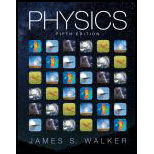
How is the air pressure in a tightly sealed house affected by operating the furnace? Explain.
Answer to Problem 1CQ
Explanation of Solution
Write the expression for ideal gas equation.
Here,
Since the furnace is operated in the tightly sealed house due to which the temperature in the tightly sealed house is increased and the volume is constant
From ideal gas equation, it is seen that the pressure is directly proportional to the temperature.
So the air pressure is increased in the tightly sealed house.
Conclusion:
Therefore, the air pressure increases in the tightly sealed house by operating the furnace due to the increase in the temperature.
Want to see more full solutions like this?
Chapter 17 Solutions
Physics (5th Edition)
Additional Science Textbook Solutions
Microbiology: An Introduction
Campbell Biology in Focus (2nd Edition)
Campbell Biology (11th Edition)
Chemistry: An Introduction to General, Organic, and Biological Chemistry (13th Edition)
Campbell Biology: Concepts & Connections (9th Edition)
Microbiology with Diseases by Body System (5th Edition)
- A window washer stands on a uniform plank of mass M = 142 kg and length l = 2.80 m supported by 2 ropes attached at the ends of the plank. The window washer has a mass m = 68.0 kg. What is the tension in each of the ropes, T1 and T2, if the window washer's displacement from the center of mass of the plank is x = 0.930 m as shown in Figure 1: Window Washer Problem?arrow_forwardA man holds a double-sided spherical mirror so that he is looking directly into its convex surface, 33 cm from his face. The magnification of the image of his face is +0.17. What will be the image distance when he reverses the mirror (looking into its concave surface), maintaining the same distance between the mirror and his face? Be sure to include the algebraic sign (+ or -) with your answer.arrow_forwardHow do you draw a diagram of the ruler and mass system in equilibrium identifying the anti-clockwise torque and clockwise torque? How do I calculate the anti-clockwise torque and the clockwise torque of the system with the ruler and the washers, does it come from the data in table 4? Please help, thank you!arrow_forward
- Example Double pane windows have two panes of glass (n = 1.5), with a layer of air sandwiched between them. If light from outside enters the first pane at an angle of 25° from the surface normal, what angle does it enter the house at? ☑ 3 5arrow_forwardDid your experiment results in Data Table 3 verify, to within a reasonable experimental error, the condition of equilibrium of Equation 6: Στanti-clockwise = Στclockwise? Support your response with experimental data. What does this Σ mean? My results do not show they are equal to each other, what does this mean then, and what does the data show? Thanks!arrow_forwardmicro wave.arrow_forward
- Don't use ai to answer I will report you answer.. Find amplitude?arrow_forwardkerjakanarrow_forwardAn object is placed 37.4cm in front of a diverging lens with a focal length of 18.1 cm. Please provide your answers in units of cm if necessary. bookmark_border1.0p3a Find the image distance. Answer Updated 6 days ago Show feedback bookmark_border1.0p3b Is the image real or virtual? Real Virtual Updated 6 days ago Show feedback bookmark_border1.0p3c Suppose the object is brought to a distance of 10.3 cm in front of the lens. Where is the image now with respect to its previous location? (Note: Ensure the sign convention you use is consistent by treating all image distances on the object side of the lens as negative.) Answer Updated 7 minutes ago Show feedback bookmark_border1.0p3d How has the height of the image changed if the object is 84.2 cm tall? Answerarrow_forward
 Glencoe Physics: Principles and Problems, Student...PhysicsISBN:9780078807213Author:Paul W. ZitzewitzPublisher:Glencoe/McGraw-Hill
Glencoe Physics: Principles and Problems, Student...PhysicsISBN:9780078807213Author:Paul W. ZitzewitzPublisher:Glencoe/McGraw-Hill
 College PhysicsPhysicsISBN:9781285737027Author:Raymond A. Serway, Chris VuillePublisher:Cengage Learning
College PhysicsPhysicsISBN:9781285737027Author:Raymond A. Serway, Chris VuillePublisher:Cengage Learning Principles of Physics: A Calculus-Based TextPhysicsISBN:9781133104261Author:Raymond A. Serway, John W. JewettPublisher:Cengage Learning
Principles of Physics: A Calculus-Based TextPhysicsISBN:9781133104261Author:Raymond A. Serway, John W. JewettPublisher:Cengage Learning College PhysicsPhysicsISBN:9781938168000Author:Paul Peter Urone, Roger HinrichsPublisher:OpenStax College
College PhysicsPhysicsISBN:9781938168000Author:Paul Peter Urone, Roger HinrichsPublisher:OpenStax College Physics for Scientists and EngineersPhysicsISBN:9781337553278Author:Raymond A. Serway, John W. JewettPublisher:Cengage Learning
Physics for Scientists and EngineersPhysicsISBN:9781337553278Author:Raymond A. Serway, John W. JewettPublisher:Cengage Learning





